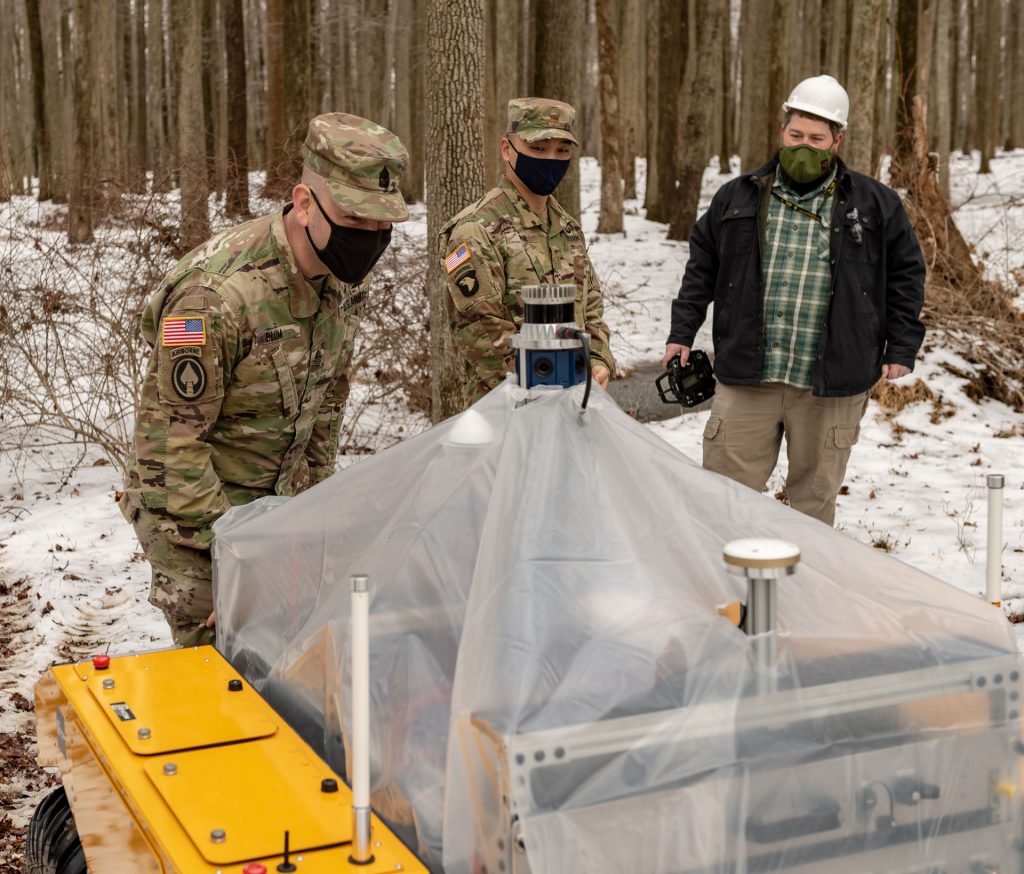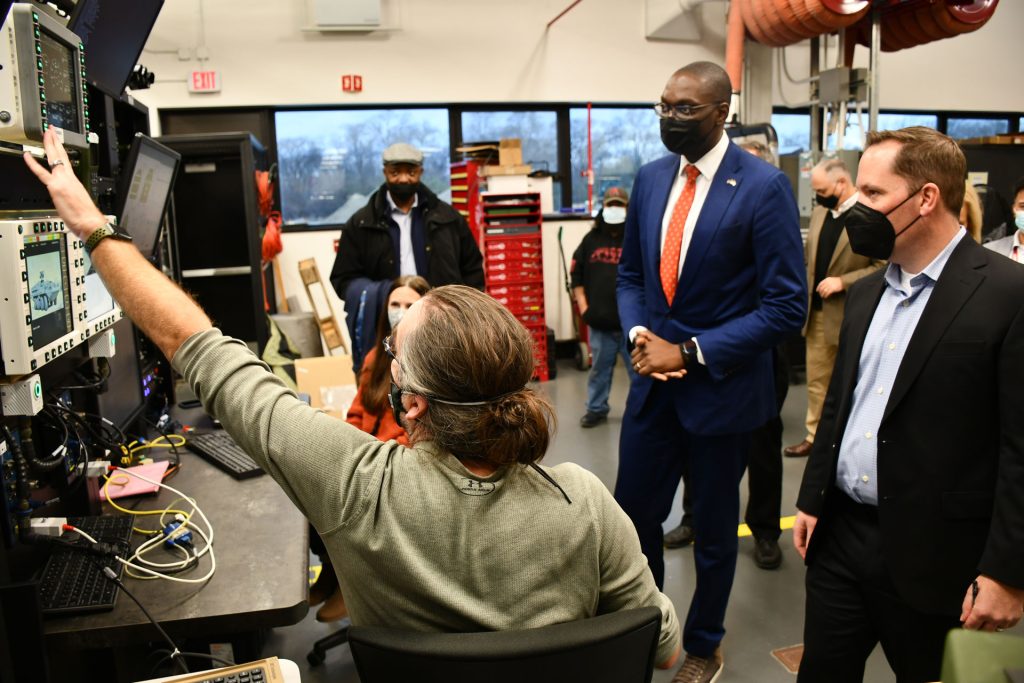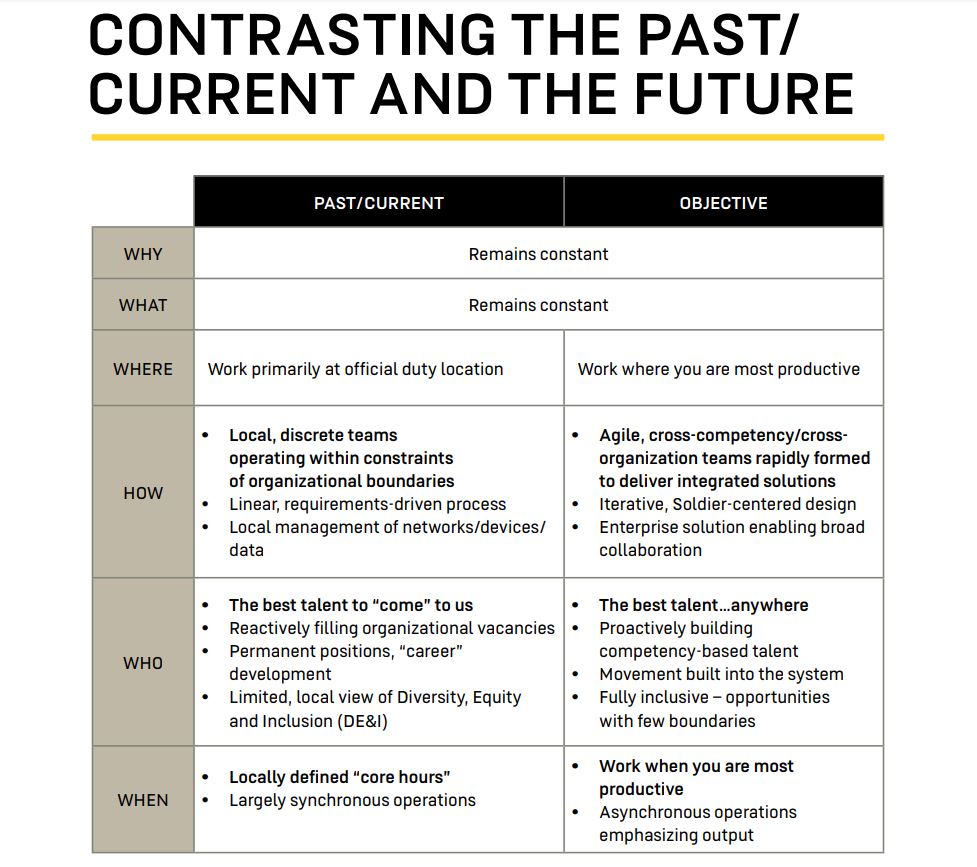
We’re all living in an experiment about the “future of work,” but DEVCOM’s leaders say the real secret of the future of work is that it’s really about the present
by Ellen Summey
It’s all a big experiment. Telework, remote work, hybrid work, day-to-day interactions with colleagues on Microsoft Teams—though the Army didn’t plan to undertake this massive pandemic-related workforce experiment, the Combat Capabilities Development Command (DEVCOM) has taken advantage of the opportunity to study its effects and plan for what’s next.A major subordinate command of Army Futures Command, DEVCOM is the Army’s largest technology developer, with a total workforce of about 25,000 people in a variety of research, development and engineering roles at more than 100 locations around the world. “A lot of what we do is lab experimentation—you try something new out in the lab and you see how it goes,” explained John Willison, DEVCOM’s deputy to the commanding general. “This, basically, was a lab experiment on ourselves, for over a year. Obviously it was a forced experiment, but we had the opportunity to run an experiment we probably would have had a little bit of a harder time selling before.”
That experiment: Offering the flexibility to the entire workforce to work “where and when they are most productive.”
If February 2020 was the last true control, they’ve been living the test ever since.

BEST IN A LABORATORY: Soldiers and scientists observe autonomous ground vehicle tests at the DEVCOM ARL Research Robotics Collaboration Campus in Graces Quarters, Maryland. Some jobs, like those at DEVCOM ARL, cannot be performed safely at home. DEVCOM is taking those conditions into account with its future of work concept. (Photo by Neil Adams)
POSTURED FOR SUCCESS
Why is DEVCOM at the forefront of this hybrid work initiative? According to Willison, the command had already been focusing its efforts on talent management before the pandemic. “Four years ago, we started putting a greater emphasis on talent management,” he said. Willison and DEVCOM leaders had worked for about 18 months to publish a comprehensive talent management strategy. “We’re an organization that does research, development and engineering, but in the end really, it’s a people business. So, we went through a phase of defining six talent domains over 70 different competencies within those domains, and really getting to an understanding of the talent that we have, the talent that we think we need in the future, and everything having to do with talent, talent engagement, talent recruitment, etc.”
Then, as the talent management initiative was being implemented, COVID-19 forced an unplanned change. “As the pandemic hit in March and April of 2020, our immediate reaction was to take care of the workforce,” Willison recalled. “We pushed everyone remotely, with the primary focus being the health and wellness of the workforce.” This is what he refers to as “phase one” of the future-of-work experiment—the period marked by the reactive steps the command took to adapt to the pandemic. But a reactive posture has a short shelf life, and DEVCOM leaders knew they needed to plan their next steps.
“By August of 2020, we were going into the fall and this seemed a little more enduring than probably anyone had expected,” Willison said. “I went in to our [commanding general] at the time, Maj. Gen. [John A.] George, and said ‘I’m seeing a lot of anxiousness in the workforce. They don’t know what’s coming, they don’t know what to expect.’ So we took a step in August to tell our workforce that we want everyone to continue to work remotely to the maximum extent possible, through December. We wanted to give them at least that certainty, or that assurance.”
“Shortly after we put that out, the boss came in and said ‘OK, now what?’ And I said, ‘That’s a great question,’ ” he chuckled. This was when the idea started to take shape. “We had an eye on, by the end of December or early January, publishing a concept paper for our workforce—and we did that in January. It said basically, the ‘why’ of our mission and the ‘what’ of our mission are not going to change. Why we exist as an organization, what we do as far as our mission, isn’t going to change. But the ‘where’ and the ‘when’ and the ‘who’ and the ‘how’ are likely going to change, so we looked at how we define that change, how we give people some idea of where we were and where are we going.”

THE BREAKDOWN: This chart illustrates the DEVCOM workforce, broken out by work “domain,” and the percentage of employees who were on hybrid versus traditional work in fiscal year 2021. (Source: DEVCOM Public Affairs Office. Graphic by the author)
NEXT STEPS
“The Army is looking at Army Futures Command in general for innovation and for doing things differently, so that also applied to the future of work. Army Futures Command, in turn, turned and looked at us because we had this foundation of doing talent management work and we really were leaning forward, so we’ve had the luxury of their support throughout,” Willison said.
“We adopted this construct of ‘work where and when you’re most productive.’ It sounds pretty simple, it makes a lot of sense, but there’s a lot of complexity in that, given the range of different things that we do and the requirements of what we do,” he explained. “So we published the concept paper in January and allowed people to start interpreting or applying those concepts locally, where they were.”
By August of 2021, DEVCOM leaders briefed Gen. John M. Murray, then-commanding general of Army Futures Command, on their strategy to pivot from their reactive posture to a hybrid-work pilot that was more future-focused. “It laid out those concepts of why, what, where, when, how, who, and gave people some broad guidance of the range of acceptable practices within all of that,” he said.
“We talk about the range of acceptable practices—that’s what Gen. Murray tasked us to do. I went back to him and said, ‘OK sir, the range of acceptable practices—people can work remotely anywhere between zero and 100 percent.’ I wasn’t sure how that was going to be received, frankly,” Willison laughed. But Murray approved the plan, and the team continued their work of communicating and implementing the pilot while tracking data regarding its effectiveness.
“We’ve got some people who have come in every day since the pandemic. We’ve had some people who haven’t come in since the pandemic started, and won’t ever come back in again. And we’re good with that.” The key, he said, is tailoring the approach for each specific location and team, and the requirements of the work itself.
“Our assertion is that we’ve been able to do all this while being at least as productive as we were before, if not more,” Willison explained. “So, we’ve got a real concerted effort now to collect metrics to make sure we’re keeping our eye on that, because that will really then take us from this pilot phase to the ultimate phase, which is, adopting this as just the way we do things in phase three.”

SPREADING THE NEWS: Willison, left, speaks to Dr. Robert Kania, U.S. Army Ground Vehicle System Center, at the Association of the U.S. Army annual meeting and exposition in Oct. 2021. DEVCOM’s future of work concept has been widely discussed among DOD organizations since its inception. (Photo by DEVCOM Public Affairs)
SOMETHING TO TALK ABOUT
Word has gotten out about this pilot—and people have questions. “One of the things we learned up front is you cannot over-communicate with your own workforce,” Willison said. “In this time of uncertainly, you cannot keep them informed enough, you cannot over-communicate. So that communication, naturally, does not stay within our organization.”
DEVCOM’s Future of Work Concept has been covered widely in government news circles. There are podcasts, articles, videos and social media content across the internet featuring Willison’s confident and positive explanations of the initiative.
One question he hears frequently—“How are you doing this?” Willison said the answer is both simple and unexpected. “My own boss has asked this, Gen. Murray has asked this, other people have asked this, and they’re surprised with the answer when I tell them we’ve been able to do all of this within existing policy, within existing regulations,” Willison said. “We’re not breaking any rules. It’s kind of remarkable if you think about that. That means a lot of these flexibilities existed for a while and just weren’t really employed to the extent they are now.”
Through his conversations with other government agencies, Willison said he has seen an array of different approaches. “You see a lot of organizations that want to put that range of acceptable practices—they want to define that [to be] a little bit more constrained and say ‘you’ve got to be in the office at least two days a week,’ which I’ve seen from some people. If that works for you, that works for you. We just couldn’t figure out how ever to put those rules out and not be leaving out someone who could be even more productive in another way.”
For Willison and DEVCOM, it all comes down to flexibility and a willingness to trust the workforce. “You’ve got to be willing to trust your managers and leaders, and in turn, they’ve got to be willing to trust their workforce,” he said. “That’s palatable to some people and less palatable to some others, depending on your leadership style and your kind of belief and how you got to where you are.”
But anytime he is challenged on DEVCOM’s approach, he said his reply is the same. “We’ll be talking about ‘the great resignation’ even more, if we start telling everyone come back to [the office]. ‘Let’s pretend like this never happened.’ You’ll see people who that just won’t work for.”
| MANAGEMENT AND MISSION COMMAND
Douglas McGregor was a professor of management at MIT in the 1950s who developed the Theory X and Theory Y models of work motivation and management. Essentially, a person who subscribes to the Theory Y style of management would believe that employees are generally self-motivated to do their work, and can be trusted to complete their tasks without close supervision. Theory X, on the other hand, states that employees are inherently lazy and lack ambition, and that they must be punished or rewarded in order to maintain productivity. DEVCOM’s willingness to embrace telework, remote work and hybrid work seems to have a few things in common with McGregor’s Theory Y, and Willison also sees a parallel between that model and the Army’s mission command doctrine. “I have not always been a Theory Y person. I was a strong Theory X person for a period of my career,” Willison laughed. As he tells it, the change occurred around the time the Army was transitioning from a command-and-control doctrine to mission command. “The whole premise of command and control was very hierarchical. Orders come from the top, they’re pushed down, they’re implemented below, and you manage compliance. This was the Army’s doctrine.” As the Army began to grapple with unconventional adversaries in Afghanistan and Iraq, Willison said leaders began to realize “this wasn’t working.”  TWO SCHOOLS OF THOUGHT: Some managers believe employees are inherently lazy and need to be punished or rewarded to maintain productivity. Others believe employees are generally self-motivated and don’t need close supervision. (Graphic by the author) “We were fighting an enemy without a hierarchy, we were fighting an enemy that was very adaptive, things were moving and changing so fast on the ground, that if we really wanted to fight more effectively, we had to go to mission command. That is, commanders give broad intent and then they enable disciplined initiative based on trust, within that intent, and then we saw how things turned around.” On a personal level, Willison had the same realization. “For me, I was working in the mission command space, and it happened to be right at a period where I was starting to figure out that Theory X also was not a great leadership model and I was not seeing it be as effective,” he laughed. “At one point, I had a little professional crisis and said ‘Geez, I’ve gotta figure out a different way.’ So, if this works for the Army, why wouldn’t it work as a leadership model? As a leader, what I’m doing is providing broad intent and giving you trust to apply disciplined initiative within that intent. When you think of ‘future of work,’ it’s really an extension of that.” “It’s like, if you trusted me enough to hire me, then trust me enough to work on something without watching me, or thinking that watching me is going to make me more productive. Frankly, the people who work hard are going to work hard no matter where they are. The people who don’t work hard, aren’t going to work hard, no matter where they are,” Willison said. “The notion that, if you’re watching them, they’re going to work hard, it just doesn’t work and it’s exhausting, as a leader. I got there through a series of hard lessons.” |

WORK CONTINUES: Garlin Gilchrist, center right, Michigan’s lieutenant governor, was at Detroit Arsenal in late 2021 for briefings on Ground Vehicle Systems Center (GVSC) modernization. He toured some of GVSC’s integration laboratories, where work many staff continued working in the office throughout the pandemic. (Photo by GVSC)
BENEFITS AND CHALLENGES
It wouldn’t be a true experiment if we didn’t talk about the results. According to Willison, the future of work pilot has been well received by the workforce so far and has shown promising outcomes already. Among the many anticipated benefits of this pilot, he said DEVCOM leaders are optimistic that it will help with workforce development, recruiting, retention, diversity and collaboration across areas of the command.
“We think that by adopting that ‘where and when’ construct, we’ll be able to open up opportunities for a group of talent that we probably haven’t even been able to track before, and be able to retain the talent that we’ve got.” A broader and more diverse talent base will be a net positive for the organization, he said. “We’re a creative organization, so we want diversity of thought, and diversity of thought comes from a diverse workforce,” he said. “It’s always been in our minds and part of our talent management strategy to look at our diversity, equity and inclusion posture, so this was another opportunity to think about how to attract talent that we may not have been able to attract before.”
With greater flexibility, Willison is also looking forward to creating new professional opportunities for the workforce. “The part I’m most excited about for the enduring future, is providing people opportunities that aren’t constrained to their geography,” he said. “We’ve got over 100 locations worldwide. If I’m sitting somewhere and I see an opportunity in another location that I could potentially be involved in, that opportunity space now got really broadened for me.”
And so far, he said, the pilot is paying off. The command has seen new innovation, new collaboration and new thought as a result of these changes. “So, it’s not just that we’re doing this because it makes us feel good,” Willison continued. “I absolutely believe it’s going to allow us to move forward as an organization from the mission output point of view as well.”
But there are challenges, too. Simply put, there are some jobs that just can’t be done from home, and managers will need some new skills to effectively lead remote and hybrid teams. “We’ve had some people who have continued to come in every day since the pandemic,” Willison said. ”There are some things that can only safely and effectively be done in a very controlled, secure lab. So, you can’t tell the person working on anthrax defense to do that at home in their kitchen.”
Some research has indicated that workers who spend more time in the office may receive more promotions, pay increases and favorable reviews than their peers who work from home more frequently. In addition, women and people of color may be more likely to prefer telework and remote work, which begs the question—how can managers ensure those workers are not negatively impacted by so-called proximity bias? “Management of hybrid work is definitely a challenge,” Willison said. “Part of what we’ve emphasized is that, the expectation is that you’re managing output. You’re not managing physical presence. You’re not managing time put in. This should have been true even before COVID, right?” Though he concedes that can be difficult in certain fields. “For us, doing research, doing engineering, we have ways to do that that are not always as tangible as we’d like them to be. It still is a level of effort, but it’s put even a greater emphasis on the notion of managing output.”
Willison said that DEVCOM leaders have taken a hard look at the roles and expectations of managers and leaders in particular, and how to ensure that favoritism and bias don’t creep in to the evaluation process. (Read more about how leaders can adapt to managing hybrid teams in “Future of Work—Present Tense,” from the Winter 2022 issue at https://go.usa.gov/xtF7P.)
Despite the difficulties, Willison said this is something that simply must be done if DEVCOM is to effectively recruit and retain the right workers for its mission. “One of the motivators for us to provide this kind of flexibility to the workforce is because we are constantly in a war for talent. If we don’t provide those flexibilities, we know someone else is going to.”

CHOOSE YOUR OWN ADVENTURE: The DEVCOM future of work concept advocates for a hybrid workforce, with the employees choosing their most productive work environment. (Graphic by DEVCOM)
CONCLUSION
Though the experiment is ongoing, Willison is already making predictions about the final outcomes. “Even though we’re calling it a pilot, there’s no way you can put this back in the box,” he said. “You know, we call it the ‘future of work,’ but it’s really the now of work. There’s no way to go back.” A hybrid workforce will be an enduring result of the pandemic for DEVCOM, he said. “It will look different and people will continue to evolve it and change it, but I’m really optimistic and really encouraged by seeing how it’s been embraced.”
“There are certainly challenges, including performance, measures, managing a hybrid workforce and biases, and those aren’t to be minimized or trivialized—those are all significant and we’ll have to get at them, but I’m really enthused by what I’ve seen so far and really optimistic about the future.”

ELECTRIFYING RESEARCH: The Honorable Kathleen H. Hicks, Ph.D., center left, the deputy secretary of Defense, talked to staff at the Ground Vehicle Systems Center (GVSC) at Detroit Arsenal about how electrification research and development efforts can improve vehicles’ mission duration and advanced warfighting capabilities. (Photo by GVSC)
For more information, go to the DEVCOM Future of Work Concept page: https://go.usa.gov/xtmUp.
ELLEN SUMMEY provides contract support to the U. S. Army Acquisition Support Center at Fort Belvoir, Virginia, as a writer and editor for SAIC. She holds an M.A. in human relations from the University of Oklahoma and a B.A. in mass communication from Louisiana State University. She is certified as a Project Management Professional, Change Management Professional and User Experience Manager, and has more than 15 years of communication experience in both the government and commercial sectors.







